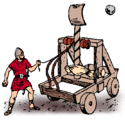


Is the direction of something thrown from a catapult a concave or convex arc? Learn what each means here. The word catapult is more well known and more likely to be used in a general way to refer to any machine resembling one. The version known as the trebuchet came later and was used until the advent of gunpowder weaponry like the cannon. Many threw stones, but some were designed to fling darts or spears. Use of catapults is first recorded around 400 BCE in both China and Greece. Specific versions sometimes have names, such as mangonel, onager, and ballista. The word catapult is most commonly associated with the kind in which a long arm flings a projectile through the power of released tension created by a twisting mechanism-the arm is pulled down and then released so that it springs forward and hurls the object into the air. There are multiple versions that use different techniques and designs.

What is a catapult?Ī catapult is a machine for hurling projectiles. It comes from a Middle French verb meaning “to overturn” or “to fall,” from tre(s), “across” or “over,” and buc, “trunk of body.” The word bucket is based on the same buc root and, in fact, another (much less common) word for trebuchet is trebucket. The word trebuchet has been used in English since the 1300s. Today they are strongly associated with the medieval period in Europe.Ī trebuchet is just one type of catapult-other forms of catapults were used long before trebuchets were invented. Trebuchets have been used for centuries, including in ancient China. Invaders would park their trebuchets outside of an enemy castle and hurl huge rocks (among other things) to destroy the structure. The word engine refers to a piece of military machinery, and siege refers to an assault on a city or fortress. Trebuchets were historically used in what historians sometimes call siege engines, a weapon used to break down massive structures, like castle doors or walls. (In early versions of the trebuchet, that force was created by soldiers pulling down on the contraption, instead of by a weight.) Designs vary, but a trebuchet typically consists of a platform, a pole with an attached sling containing the projectile, and a counterweight-an even heavier object that is hoisted up and then dropped, raising the pole and creating the force necessary to launch what’s in the sling. The defining characteristic of a trebuchet is its use of the power of gravity. What is a trebuchet?Ī trebuchet is a machine for hurling projectiles using a sling. A trebuchet is a specific type of catapult that’s gravity-powered-it uses a counterweight that pulls down and rapidly raises another part that then flings the object from a sling. There are different kinds, but the most common involves a long arm pulled back and then forcefully released to launch a large object. ⚡ Quick summaryĪ catapult is a machine for hurtling projectiles. They are and they aren’t, but don’t worry-we’ll break down the differences in the design, physics, and functionality of trebuchets and catapults. Do you need a trebuchet? A catapult? Are they the same thing? Or perhaps you find yourself desiring to fling an enormous pumpkin an absurd distance. So, a large boulder has just been hurled at you with a medieval-looking contraption and, understandably, you want to know what it is. For all other inquiries, we’re glad to help. If a large projectile is currently hurtling toward you, move out of the way before reading any further. Welcome to the Trebuchet and Catapult Helpline.


 0 kommentar(er)
0 kommentar(er)
